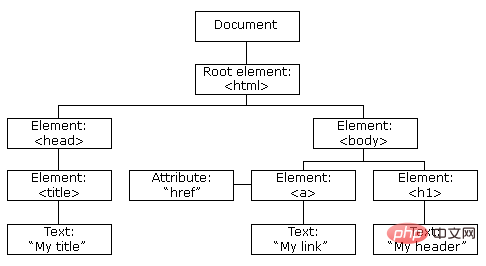Home >Web Front-end >JS Tutorial >Detailed introduction to JavaScript DOM
This article brings you a detailed introduction to JavaScript DOM. It has certain reference value. Friends in need can refer to it. I hope it will be helpful to you.
Javascript DOM (Document Object Model) is an interface that allows developers to manipulate the content, structure, and style of the page. In this article, we will understand what DOM is and how to manipulate it using Javascript. This article can also serve as a reference for basic DOM manipulation.
Basically a web page consists of HTML and CSS documents. The description that browsers use to create documents is called the Document Object Model (DOM). It enables Javascript to access and manipulate the elements and styles of the page. The model is built in an object-based tree structure and defines:

HTML DOM Model
The position of an element is called a node. Not only do elements get nodes, but attributes of elements and text also have nodes of their own (property nodes and text nodes).
The DOM document is the owner of all other objects in the web page. This means that if you want to access any object on the web page, you must start here. It also contains many important properties and methods that allow us to access and modify our own pages.
Now that we understand what a DOM document is, we can start getting our first HTML element. There are many different methods that can be used with the Javascript DOM, but these are the most common:
getElementById() The method is used to get a single element by its id. Let's look at an example:
var title = document.getElementById(‘header-title’);
We get the element with the id header-title and save it to a variable.
You can also use the getElementsByClassName() method to get multiple objects, which returns an array of elements.
var items = document.getElementsByClassName(‘list-items’);
Here we get all the items of class list-items and save them into variables.
You can also use the getElementsByTagName() method to get elements by tag name.
var listItems = document.getElementsByTagName(‘li’);
Here we get all the li elements in the HTML document and save them into variables.
querySelector() Method returns the first element that matches the specified CSS selector. This means you can get elements by id, class, tag and all other valid CSS selectors. Here I've listed some of the most commonly used options.
Get by id:
var header = document.querySelector(‘#header’)
Get by class:
var items = document.querySelector(‘.list-items’)
Get by label:
var headings = document.querySelector(‘h1’);
Get more specific elements:
We can also use CSS Selectors to get more specific elements.
document.querySelector(“h1.heading”);
In this example, we search for both tags and classes and return the first element passed to the CSS Selector.
querySelectorAll() method is exactly the same as querySelector() except that it returns all elements that match the CSS Selector.
var heading = document.querySelectorAll(‘h1.heading’);
In this example, we get all the h1 tags belonging to the heading class and store them in an array.
Changing HTML Elements
HTML DOM allows us to modify the content and style of HTML elements by changing their attributes.
The innerHTML attribute can be used to modify the content of an HTML element.
document.getElementById(“#header”).innerHTML = “Hello World!”;
In this example, we get the element with id header and set its content to "Hello World!".
InnerHTML can also put tags inside another tag.
document.getElementsByTagName("div").innerHTML = "<h1>Hello World!</h1>"
Put h1 tags into all existing divs here.
You can also use DOM to change the value of the attribute.
document.getElementsByTag(“img”).src = “test.jpg”;
In this example, we change the src of all <img alt="Detailed introduction to JavaScript DOM" > tags to test.jpg.
To change the style of an HTML element, you need to change the style attribute of the element. Here is an example syntax for changing the style:
document.getElementById(id).style.property = new style
Next look at an example where we take an element and change the bottom border to a solid black line:
document.getElementsByTag(“h1”).style.borderBottom = “solid 3px #000”;
The CSS property needs to be camelcase instead of normal css property name to write. In this example, we use borderBottom instead of border-bottom.
Now let’s see how to add new elements and remove existing elements.
var div = document.createElement(‘div’);
Here we create a div element using the createElement() method which takes the tag name as a parameter and saves it into a variable. Then you just need to give it some content and insert it into the DOM document.
var content = document.createTextNode("Hello World!");
p.appendChild(newContent);
document.body.insertBefore(p, currentp);
这里用了 createTextNode() 方法创建内容,该方法用字符串作参数,然后在文档中已经存在的 div 之前插入新的 div 元素。
var elem = document.querySelector('#header');
elem.parentNode.removeChild(elem);
本例中我们得到一个元素并使用 removeChild() 方法将其删除。
现在让我们来看看怎样替换一个项目。
var p = document.querySelector('#p');
var newp = document.createElement(‘p’);
newp.innerHTML = "Hello World2"
p.parentNode.replaceChild(newp, p);
这里我们使用 replaceChild() 方法替换元素。第一个参数是新元素,第二个参数是要替换的元素。
还可以使用 write() 方法将 HTML 表达式和 JavaScript 直接写入 HTML 输出流。
document.write(“<h1>Hello World!</h1><p>This is a paragraph!</p>”);
我们也可以把像日期对象这样的参数传给 JavaScript 表达式。
document.write(Date());
write() 方法还可以使用多个参数,这些参数会按其出现的顺序附加到文档中。
HTML DOM 允许 Javascript 对 HTML 事件做出反应。下面列出了一些比较重要的事件:
可以用标记上的属性直接在 HTML 代码中定义事件。以下是 onclick 事件的例子:
<h1>Click me!</h1>
在此例中,单击按钮时,<h1></h1> 的文本将被改为 “Hello!”。
还可以在触发事件时调用函数,如下一个例子所示。
<h1>Click me!</h1>
这里我们在单击按钮时调用 changeText() 方法,并将该元素作为属性传递。
还可以用 Javascript 代码为多个元素分配相同的事件。
document.getElementById(“btn”).onclick = changeText();
接下来看看怎样为 HTML 元素分配事件监听器。
document.getElementById(“btn”)addEventListener('click', runEvent);
这里我们刚刚指定了一个 click 事件,在单击 btn 元素时调用 runEvent 方法。
当然还可以把多个事件指定给单个元素:
document.getElementById(“btn”)addEventListener('mouseover', runEvent);
DOM Document 中的节点之间具有层次关系。这意味着节点的结构类似于树。我们用 parent,sibling 和 child 等术语来描述节点之间的关系。
顶级节点称为根节点,是唯一一个没有父节点的节点。普通 HTML 文档中的根是 标记,因为它没有父标记,并且是文档的顶部标记。
可以用以下属性在节点之间导航:
下面是得到 h1 的父元素的例子。
var parent = document.getElementById(“heading”).parentNode
望本文能帮助你理解 Javascript DOM 以及如何用它来操作页面上的元素。
本篇文章到这里就已经全部结束了,更多其他精彩内容可以关注PHP中文网的的JavaScript教程视频栏目!!!
The above is the detailed content of Detailed introduction to JavaScript DOM. For more information, please follow other related articles on the PHP Chinese website!